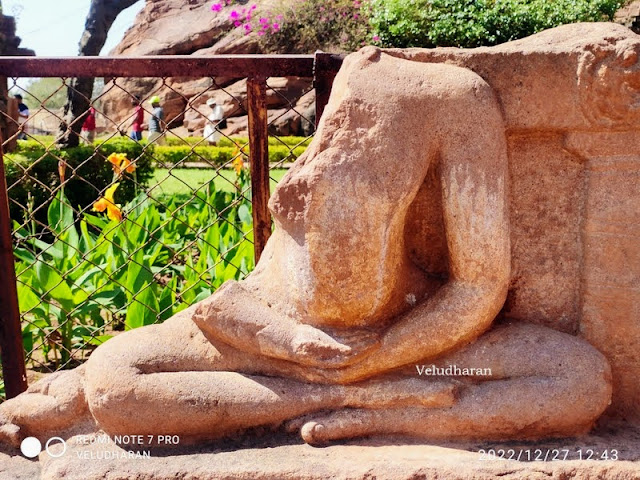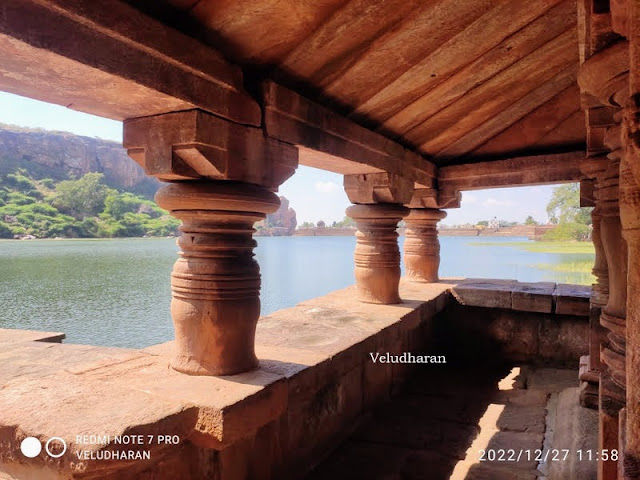The visit to this
Sri Kadasiddhesvara Temple at Pattadakal was a part of “Hampi, Badami,
Pattadakal, Mahakuta and Aihole temples Heritage visit” organized by வரலாறு விரும்பிகள் சங்கம் Varalaru Virumbigal Sangam – VVS and எண்திசை வரலாற்று மரபுநடைக்குழு, between 24th December to 28th December
2022. I extend my sincere thanks to the
organizers Mrs Radha and Mrs Nithya Senthil Kumar and Mr Senthil Kumar.
The Pattadakal temple complex on the banks of river Malaprabha comprises
nine temples near to one another in a row and from the north to south as
follows…..
1. The
Kadasiddhesvara Temple
2. The Jambulinga Temple
3. The Galaganatha Temple
4. The Chandrasekhara Temple
5. The Sangamesvara Temple
6. The Kasi Visvesvara Temple
7. The Mallikarjuna Temple
8. The Virupaksha Temple
9. The Papanatha Temple ( This temple is 200
metres away from Virupaksha Temple on south side )
கடசித்தீஸ்வரர் கோயில்.. இந்த சிறிய கோயிலின் காலம் 7ஆம் நூற்றாண்டின் இடைப் பகுதியில் இருந்து 8ஆம் நூற்றாண்டின் முற்பகுதி எனக் கருதப்படுகிறது. கிழக்கு நோக்கி கட்டப்பட்டுள்ள இந்த கோயில் நாகர வகையை சார்ந்தது. விமானத்திற்கு மேலே சிகரம் காணப்படவில்லை. கருவறை சதுர வடிவில் உள்ளது. உள்ளே சிவலிங்க திருமேனி காணப்படுகிறது. தேவகோட்டத்து சுவர்களில் வடக்கில் அர்த்தநாரிஸ்வரர், மேற்கில் அரிஅரன் தெற்கில் லகுலீசர் சிற்பங்கள் காணப்படுகின்றன. விமானம் சுகநாசிகை, முகப்பில் சிதைந்த நடராஜர் பார்வதியுடன் காணப்படுகிறார். கருவறை வாயிலுக்கு இருபுறமும் கங்கை, யமுனை சாமரம் ஏந்தியவாறு நிற்கின்றனர். வாயிலின் நடுவே உமையுடன் சிவன் அமர்ந்திருக்க, இருபக்கமும் பிரம்மா, விஷ்ணு அமர்ந்தவாறு காணப்படுகின்றனர். இடப வாகனம் கருவறையை நோக்கி அமர்ந்தவாறு உள்ளது. வாயில்காப்போர்கள் சிதைந்த நிலையில் காணப்படுகின்றனர்.
From the northern end of this temple complex, the two temples, The Kadasiddhesvara
Temple and the Jambulinga Temple, are one beside the
other. They are modest and plain and broadly similar to each other in plan,
form, elevation and style. Both are of rekha- nagara model. Each of them has a
closed flat roofed mandapa without pillars and with the doorway in the front
approached by a flight of steps. On the exterior of the walls of the garbha-
griha is a deva-koshta containing an image of a deity. In the mukha-patti of
the sikhara is a panel of natya Siva. The amalaka and kalasa of the sikhara of
both the temples are missing.
ARCHITECTURE
Originally, as
attested by the frontward projecting corbels of the front wall pilasters there
was a mukha-mandapa to each of them that had disappeared in course of time.
The
entrance lintel has beautiful images of Shiva and Parvati seated on a Rishabam,
flanked by Brahma and Vishnu. The temple measures 8.75 m e-w x 4.10 m
n-s, has an ornate doorway flanked by Saiva dvara-pala in the front The
dvara-bandha comprises five sakhas one of which is a zoo- anthropomorphic naga
sakha. At the bottom of the sakhas are graceful bas-reliefs of the Ganga and
the Yamuna, the river goddesses. In the dvara- bandha of the garbha-griha,
though similar to the front, one would not miss to notice a special feature in
the lalata the image of Siva and Uma his consort seated close to him and the Rishabam,
his vahana below, bold and beautiful. At the extremities of the same lintel
are: a figure of four armed Brahma to the right and of Vishnu to the left, a
format found only in this temple. Outside in the deva-koshthas on the south,
west and the north walls of the garbha-griha respectively are sculptures of
Siva, Hari Hara and the Ardhanarisvara. The last two are the spiritual
synthetic forms of Siva and Vishnu and of Siva and Sakti i.e. Purusha and
Prakriti respectively and historically implying a sincere attempt to forge
unity between the Saiva, Vaishnava and Sakta sectarians.
The Ardhanarisvara
is an excellent work of art. It is particularly noteworthy that along the top
zone of the walls runs a fine sculptural frieze of humour provocative kubja
ganas in various postures and attitudes.
HISTORY
AND INSCRIPTIONS
The temple may be dated to eight - ninth
century, by the Chalukya dynasty.
POLITICAL HISTORY OF CHALUKYA DYNASTY
Jayasimha, a Chalukya King probably the founder, carved out a
region and ruled. He was immediately followed by Ranaraga who expanded and
consolidated the kingdom. However, not much is known about these two Chalukyan
kings. It was Pulakesi I, the third king in the genealogical line, who made
Badami, the capital of the kingdom in 543 CE and built a fort on the top of
what is now known as the North hill. His son, Kirtivarma (1) with the
assistance of Mangalesa his younger brother, conquered the neighbouring
kingdoms of the Kadambas in the south- west, the Mauryas of the Konkana, the
Kalachuris etc,. It was his celebrated
grandson Pulakesi-II who extended the political boundaries of the kingdom far
and wide from Narmada to Kaveri. He installed his younger brothers Jayasimhavarma
in the north comprising Gujarath region and Kubja Vishnuvardhana in the eastern
division while he ruled the central part from Badami. However, he met with a
crushing defeat at the hands of Pallava Narasimhvarman of Kanchi in 642 CE.
Badami was 'terra incognito' for the next twelve years. In 654 CE, Vikramaditya - I, Pulakesi's son, succeeded in
re-conquering the kingdom from the Pallavas. The kingdom grew further and was
prosperous, strong and generally peaceful under the next three rulers in
succession namely: Vinayaditya, Vijayaditya and Vikramaditya II in spite of
their frequent, successful wars particularly with their arch enemy, the
Pallavas others in the north. Kirtivarman- II, the son of Vikramaditya- II
though capable and experienced in wars and administration, succumbed
to the 756 CE onslaught by Dantidurga, the Rashtrakuta chief ruling the Ellora
region. This ended the Badami Chalukyan rule. The Badami region thus became a
part of the Rashtrakuta kingdom.
By 973 CE the Chalukyas till then keeping a low
profile at the appropriate occasion seized and rose to power supplanting the
Rashtrakutas. Later Kalyana in Bidar district, Karnataka had the fortune of
becoming the capital of the kingdom and continued to be so till the ruling
dynasty fell in about 1189 CE. However, Pattadakal gained some importance by
becoming the headquarters of an administrative division known as Kisukadu ruled by Nolamba Pallava Permanadi Singhanadeva as mandalika (feudatory) under
Someshvara II, Bhuvanaikamalla, the Chalukyan king, around 1070 CE and hundred
years later by Chavumda II of the Sindha family, a mandalika to Noormadi Taila-
III the Chalukiyan king. Chavumda’s senior queen Demaladevi and their son Achideva by virtue
of his position as prince were then enjoying
Pattadakal.
Ref
1. A Hand book on World Heritage Series Badami, published by Archaeological Survey of India.
2. A Hand book on Hampi, Badami, Pattadakal & Aihole issued by VVS in Tamil.
3. Temple architecture and Art of Early Chalukyas Badami, Pattadakal, Mahakuta, Aihole by George Michell.
HOW TO REACH
Pattadakal Group of temples are 13 KM from Aihole, 17 KM from Badami and 459 KM from Bengaluru.
Nearest Railway Station is Badami.
Pattadakal Group of temples are 13 KM from Aihole, 17 KM from Badami and 459 KM from Bengaluru.
Nearest Railway Station is Badami.
LOCATION OF THE
TEMPLE : CLICK HERE
--- OM SHIVAYA NAMA ---

























































